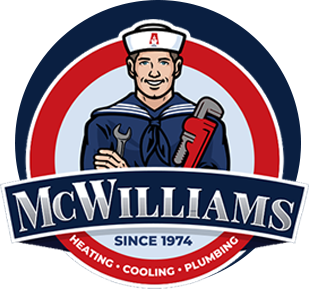
How Geothermal Heating Systems Work
As the name implies, geothermal heating systems take advantage of the earth below to provide effective heating throughout the winter months. Underground temperatures tend to remain constant, thanks in large part to the large amounts of solar energy the earth absorbs. A typical system pulls the latent heat from this underground store and transfers it to your home.
Most geothermal heating systems use water traveling within an underground piping loop to gather the ground’s heat. This heat is concentrated within the system’s ground source heat pump so it can be used to heat your home. During the summer, the whole process can be reversed to take advantage of cooler underground temperatures as the mercury climbs.
What Makes Geothermal Heating So Attractive?
Like ordinary heat pumps, geothermal heating systems offer a great deal of flexibility when it comes to heating and cooling, but with even greater energy efficiency. For example, geothermal heat pumps can be used not just to heat your home, but to provide hot water as well. This feature cuts out additional costs that would have been spent on electric or gas hot water heating.
Geothermal systems are much more reliable than their counterparts, thanks to a reduced number of components involved. These systems tend to be simplistic in their design and built with a tremendous level of durability and reliability. It’s not uncommon to see geothermal systems last for decades on end, and most units have warranties that last for 50 years or more.
These heating systems also offer greater security and peace of mind than other systems. There’s no outdoor cabinet to defend against vandals or outdoor creatures, plus the geothermal loop is safely tucked away underground. Most of the essential components are located indoors, with ease-of-accessibility first and foremost on manufacturers’ minds.
Last but not least, geothermal heating systems are valued for their relatively quiet operation. The noise of a typical heat pump with an outdoor condenser/compressor unit can be off-putting to those who find such noises distracting. Since a geothermal system doesn’t need an outdoor unit, a two-speed unit offers far quieter operation than its refrigerant-dependent counterpart.
Getting Started
Once you’ve decided on geothermal heating as a way to keep your Lufkin home warm, it’s time to get started with the selection and installation process. But before you can do that, you’ll want to make sure the land surrounding your home is suitable for a geothermal heating system installation.
There are three considerations to make when it comes to installing your new geothermal heating system: geology, hydrology and land availability.
Learning the Lay of Your Land
Your first consideration involves the geology of the land. A geothermal heating system’s ability to transfer heat is easily affected by the composition of the soil and rock underneath. If the soil has poor heat transfer properties, the geothermal system requires more piping and energy to properly deliver heat to your home. If the soil is too rocky or too shallow to create a useful installation trench, you may have to consider alternative installation options.
Hydrology is also an important factor when designing and installing a geothermal system. The wetness of the surrounding soil will have a definite impact on your new system’s overall efficiency. Geothermal heating systems submerged in water or set in wet soil tend to transfer heat more efficiently than ground loops buried in drier areas.
If your home is near a body of surface water or an extensive source of ground water, you may be able to benefit from an open-loop system that uses ground water as a transfer medium. A closed-loop system can also be set within a body of water or wet soil to increase its overall efficiency. If deemed feasible, installations set in dry soil may also be accompanied by “soaker hoses” that inject water into the surrounding ground to keep the ground loop wet.
The last, but most important consideration is the amount of land you have available for installing a geothermal heating system. This is the one factor that can have a tremendous impact on your choice of system. Depending on how much land is available, your options include:
- Horizontal ground loops – The most economical choice for geothermal heating systems and commonly installed in conjunction with newly constructed buildings. This option normally requires more land than the others.
- Vertical installation – Ideal for instances where space is at a premium or when a horizontal ground loop poses the most threat to an existing building structure or underground utility.
- Compact horizontal installation – Uses less space than most horizontal or vertical installations. These coils only require a shallow trench for installation, resulting in less disturbed space and quicker installation.
Talking Economics
It’s true that the initial cost of installing a geothermal heating system is higher than other conventional types of heating. However, this cost is usually outweighed by both the benefits of geothermal heating and how much you stand to recoup over a long-term period.
Fortunately, you may not have to shoulder the complete cost of building a geothermal heating system. For starters, incentives and special financing offers are available to help offset the costs of installing and using geothermal heating systems. For instance, there may be tax credits and other federal and state incentives available that defray your costs.
Even mortgage companies are getting into the habit of helping geothermal heating customers upgrade their heating systems at a lower cost. Some companies offer “energy-efficient mortgage” options that include this and other such energy-efficient improvements in the costs of the loan. You may want to speak to your lender for more details about this option.
Geothermal Heating vs. Other Forms of Heating
When it comes to energy efficiency, most conventional forms of heating don’t stand a chance. A typical geothermal heating system is capable of moving as much as three units of heat from the earth and into your living room for just one unit of electricity. That means geothermal heating systems use up to 50 percent less electricity than their conventional counterparts.
According to an EPA comparison between geothermal heating and other types of heating, using a typical geothermal heat pump can help you cut back on your home’s energy consumption and the resultant emissions produced by as much as 44 percent when compared to an average air-source heat pump. Against electric resistance heating, it’s no contest; a geothermal system uses 72 percent less energy.
Gas furnaces are remarkably efficient, but only 98 percent so. A geothermal heating system can surpass that efficiency percentage by leaps and bounds, with some systems achieving efficiencies as much as 600 percent in comparison to a typical gas furnace. In addition, using a geothermal system means that you won’t have to use a whole bunch of fossil fuels just to keep your home nice and toasty throughout the winter.
The Bottom Line
Geothermal heating systems offer a reliable, dependable and energy efficient way of heating your home. Over the long run, such systems can pay for themselves through the tremendous amount of energy that’s saved each year. In the process, your Lufkin home will retain all of the comfort you’ve come to enjoy, even under the harshest of weather conditions.
If you want to learn more about geothermal heating systems or get started on a new installation, contact us at McWilliams & Son Heating & Air. Since 1974, we’ve helped Lufkin and Nacogdoches area homeowners with their unique heating and cooling needs. Remember this article when your thinking about Geothermal Heating Systems: A Smart, Cost-Effective Option for Many Texas Homes.

